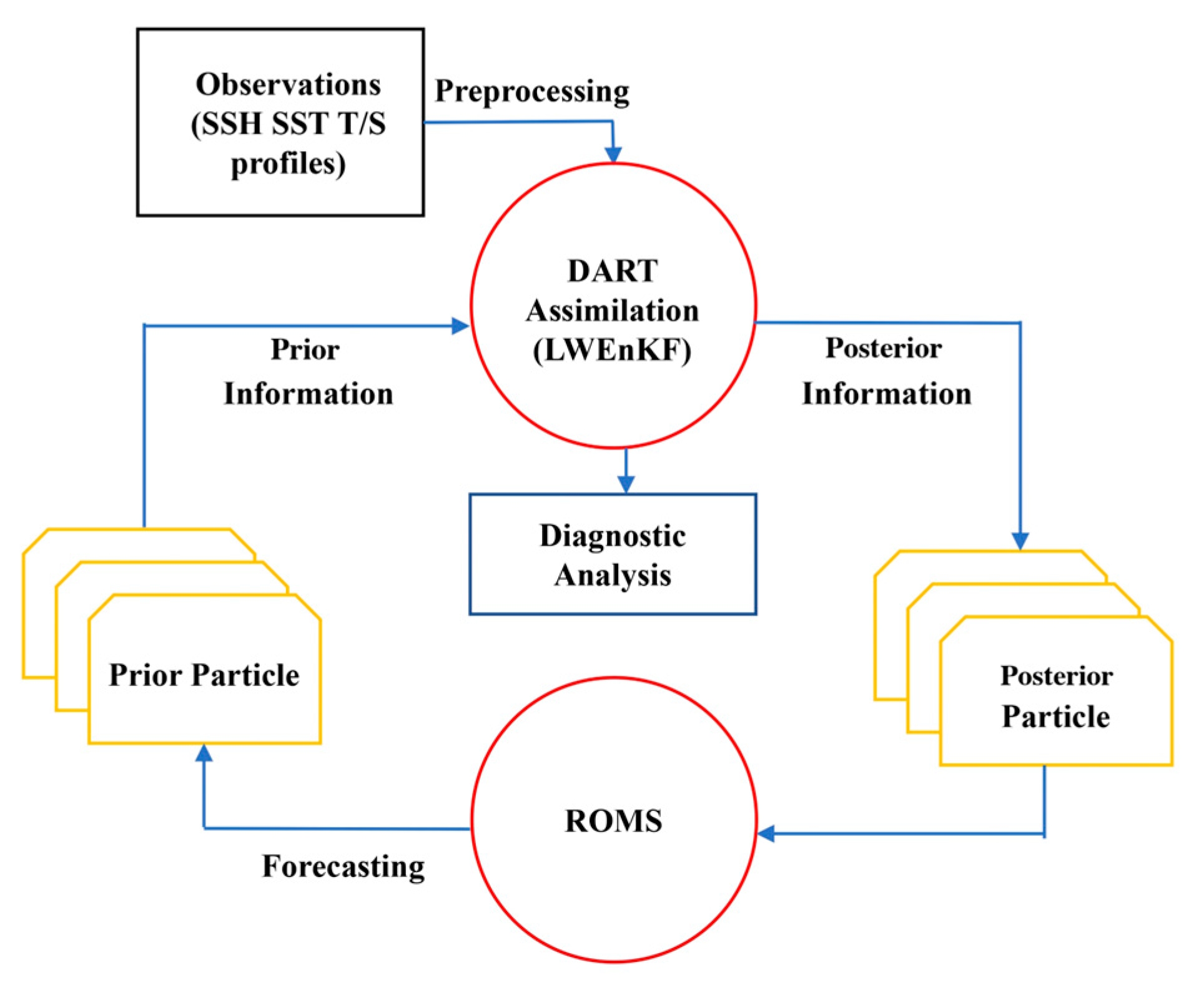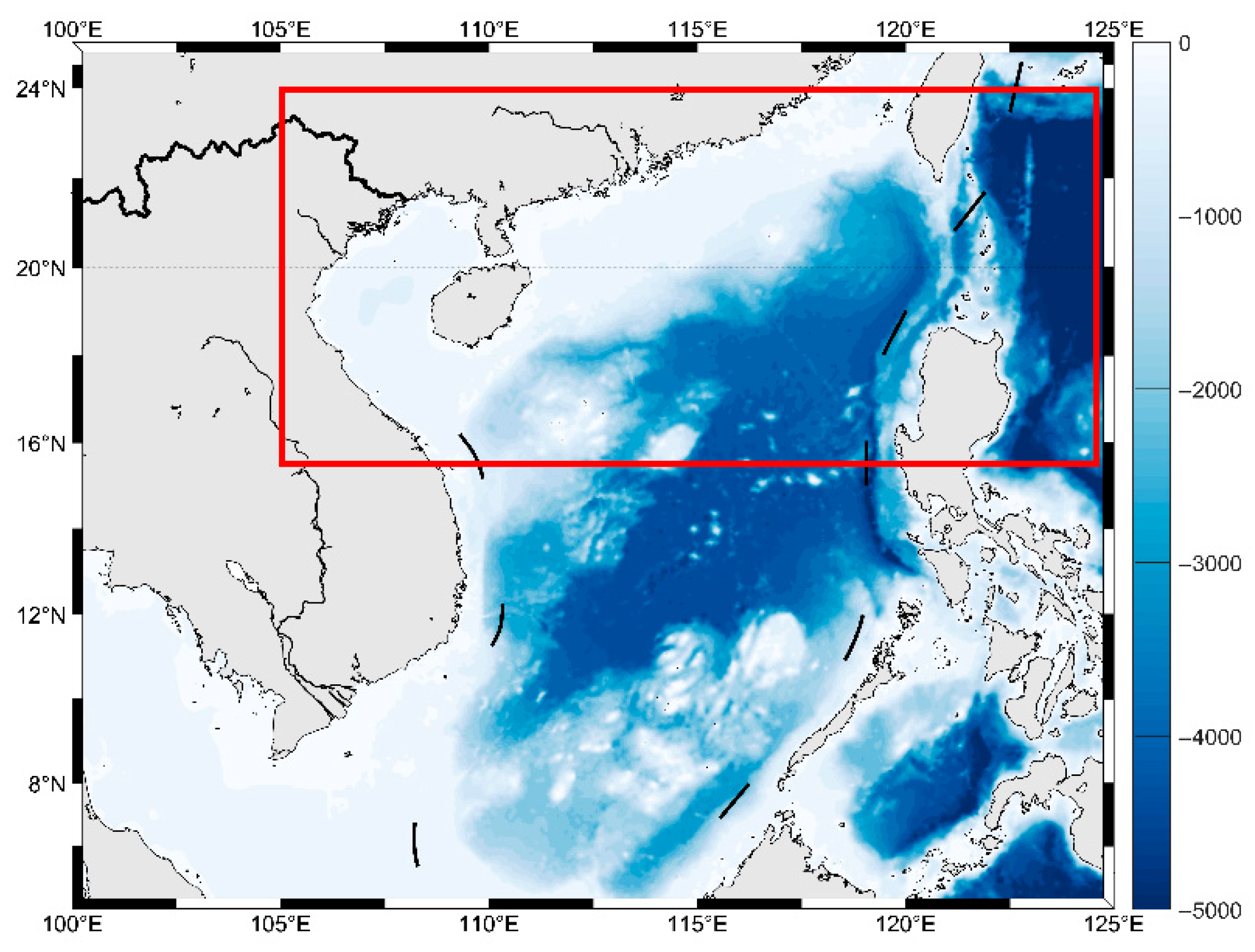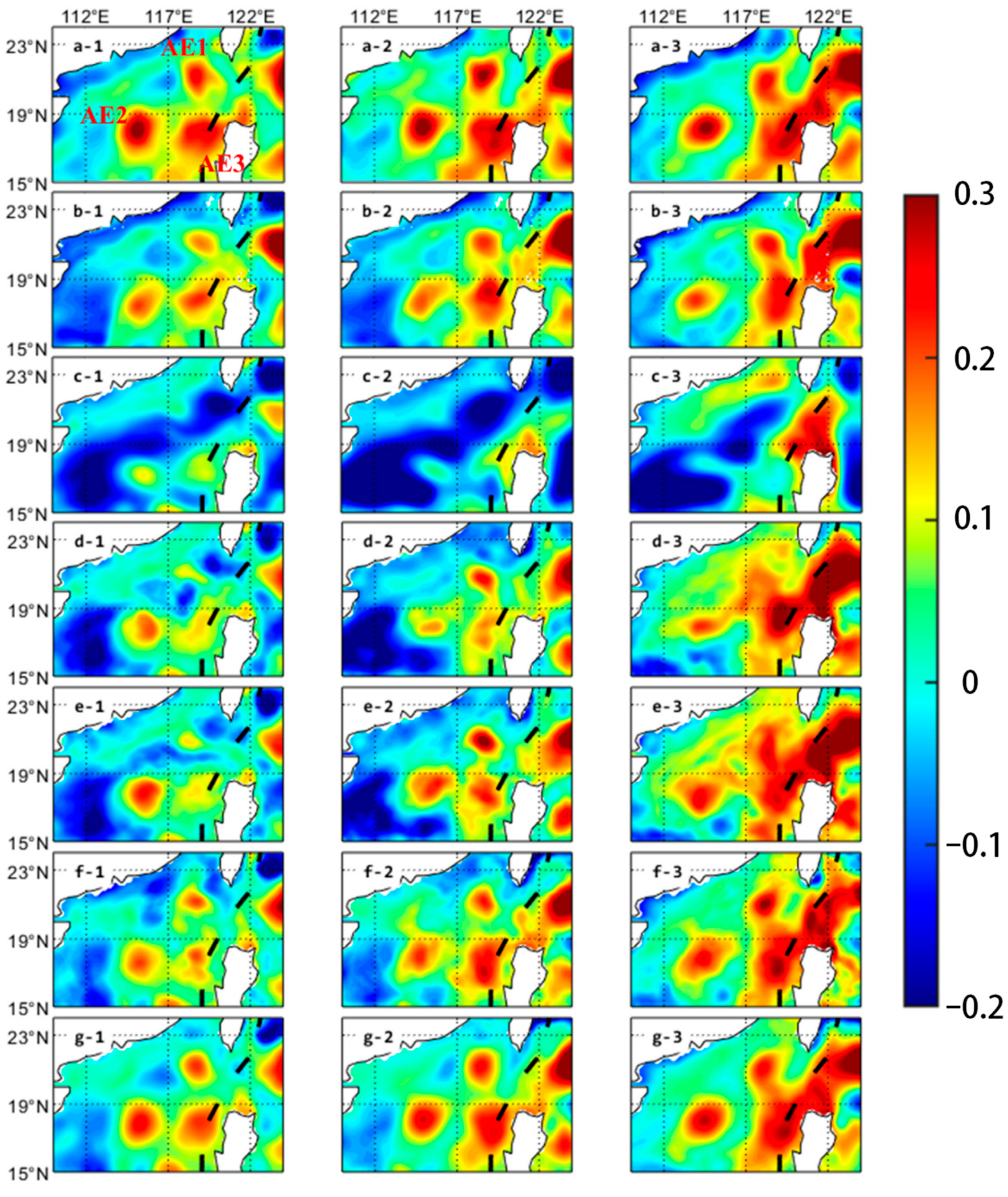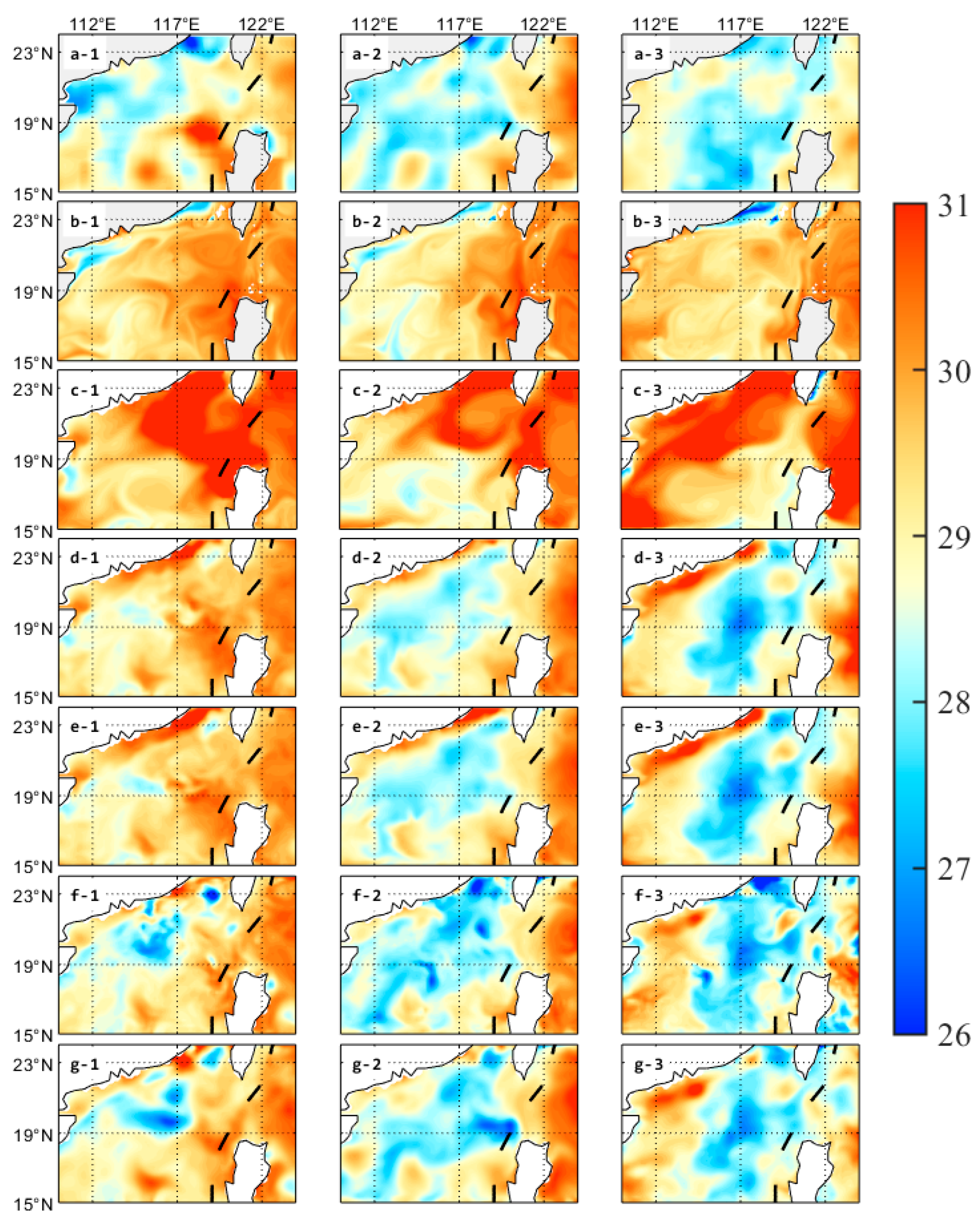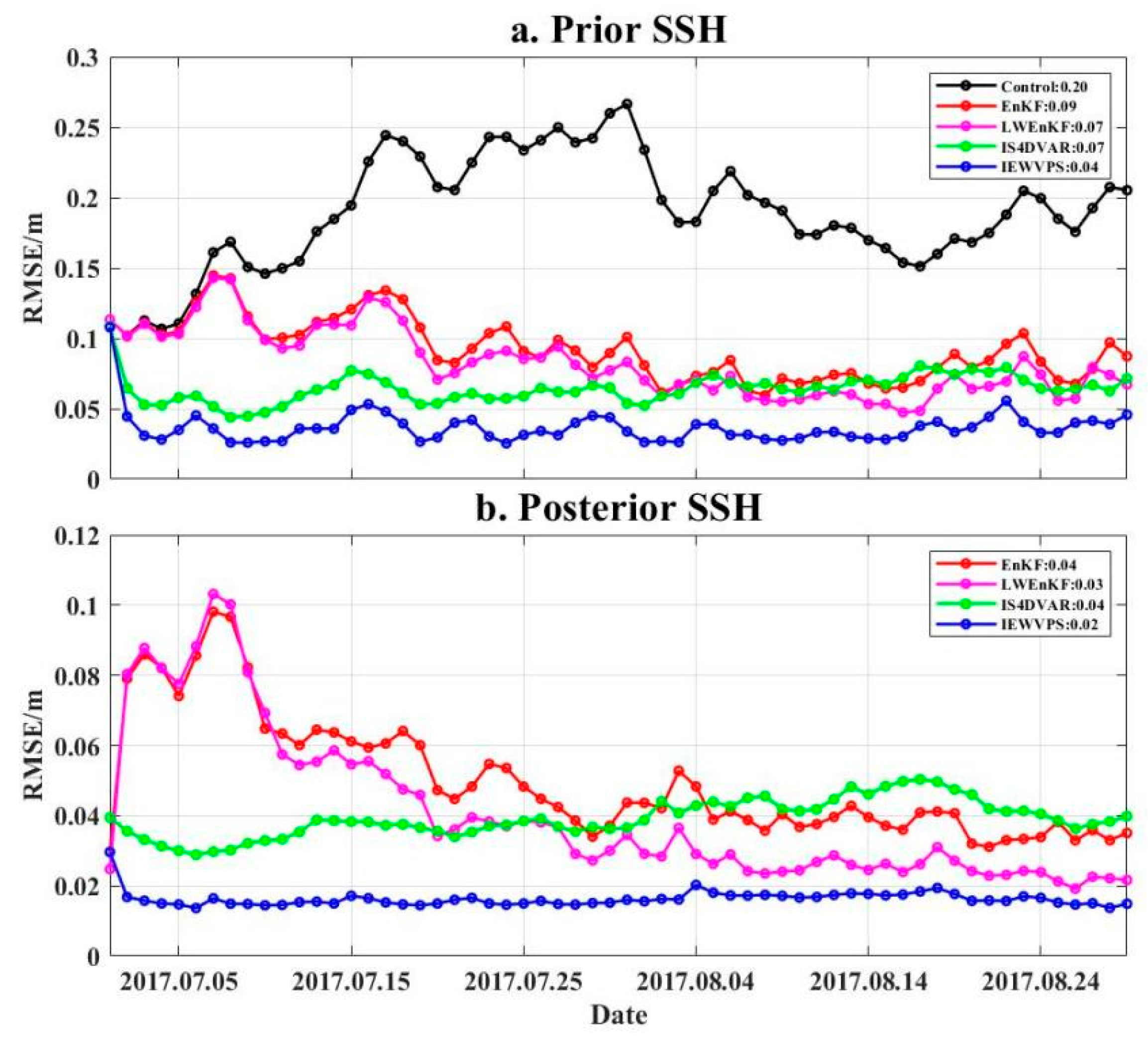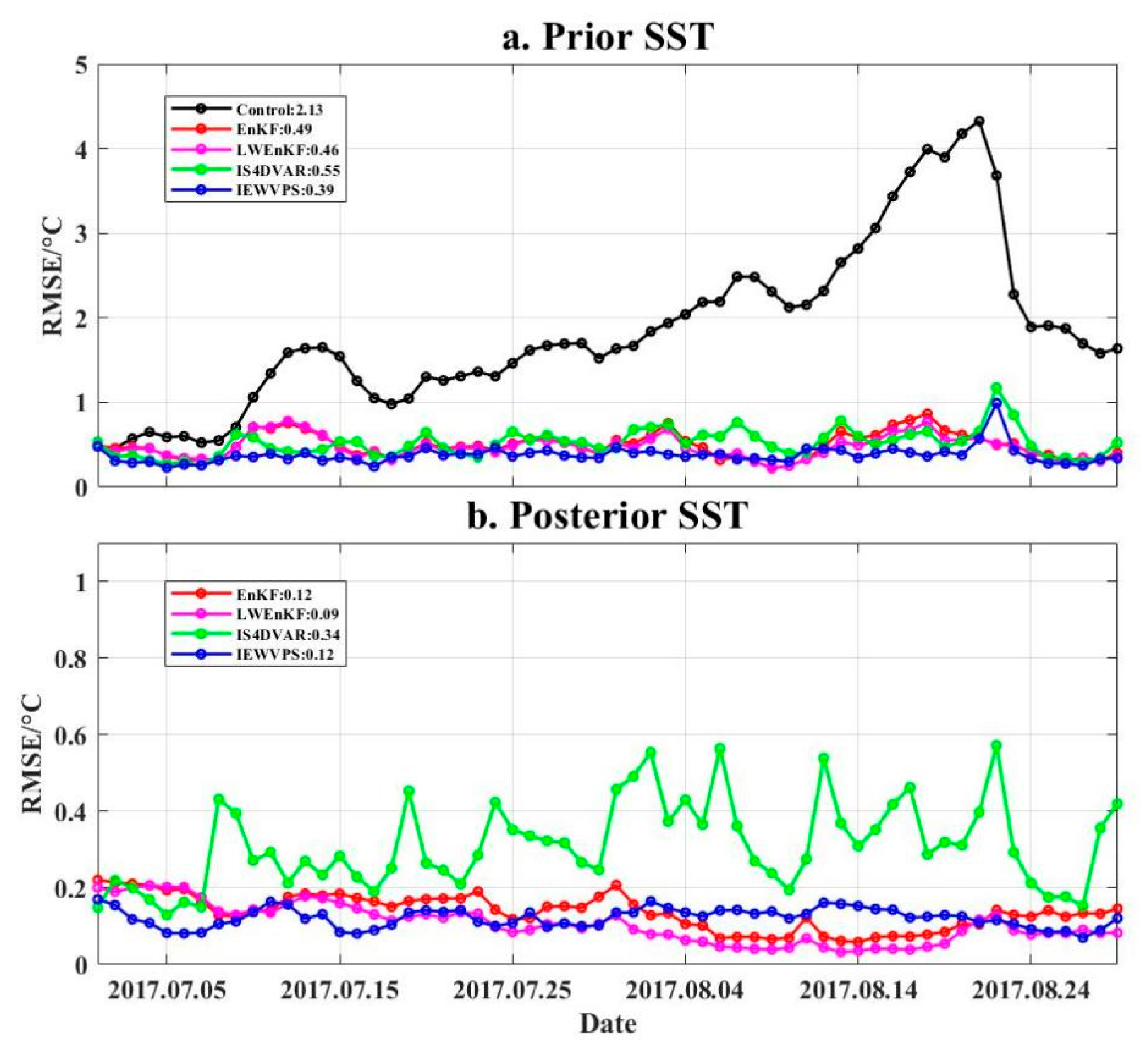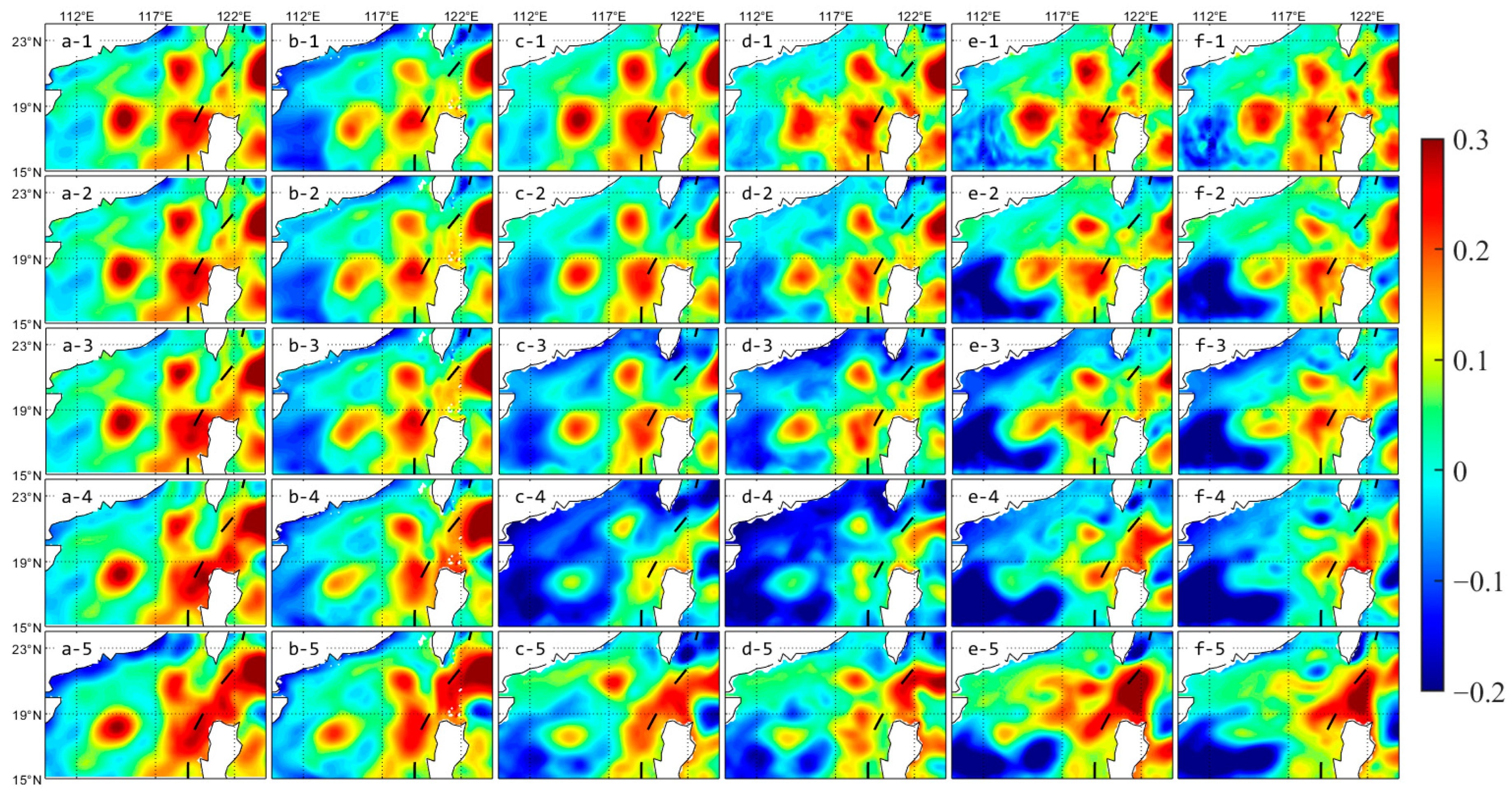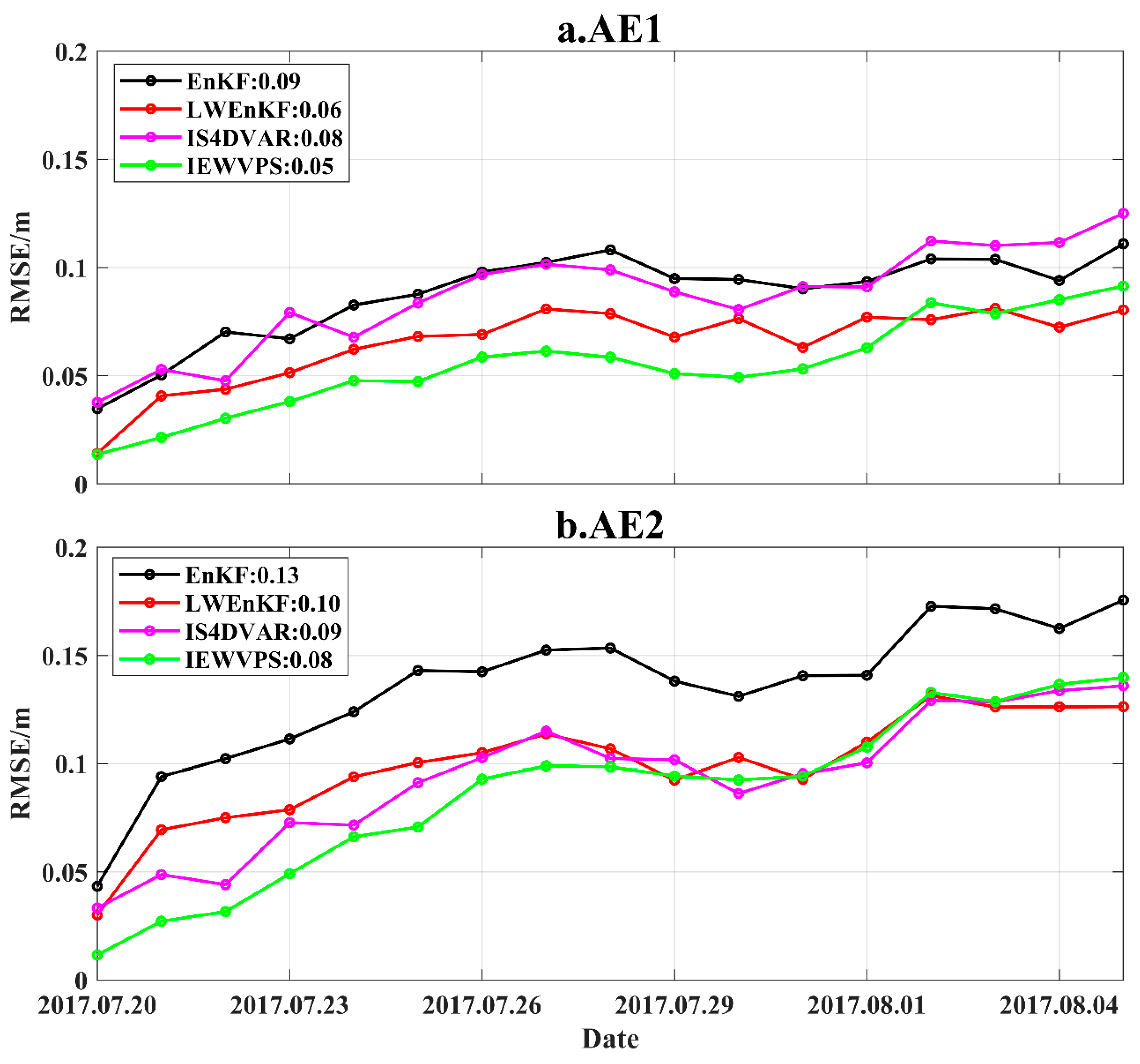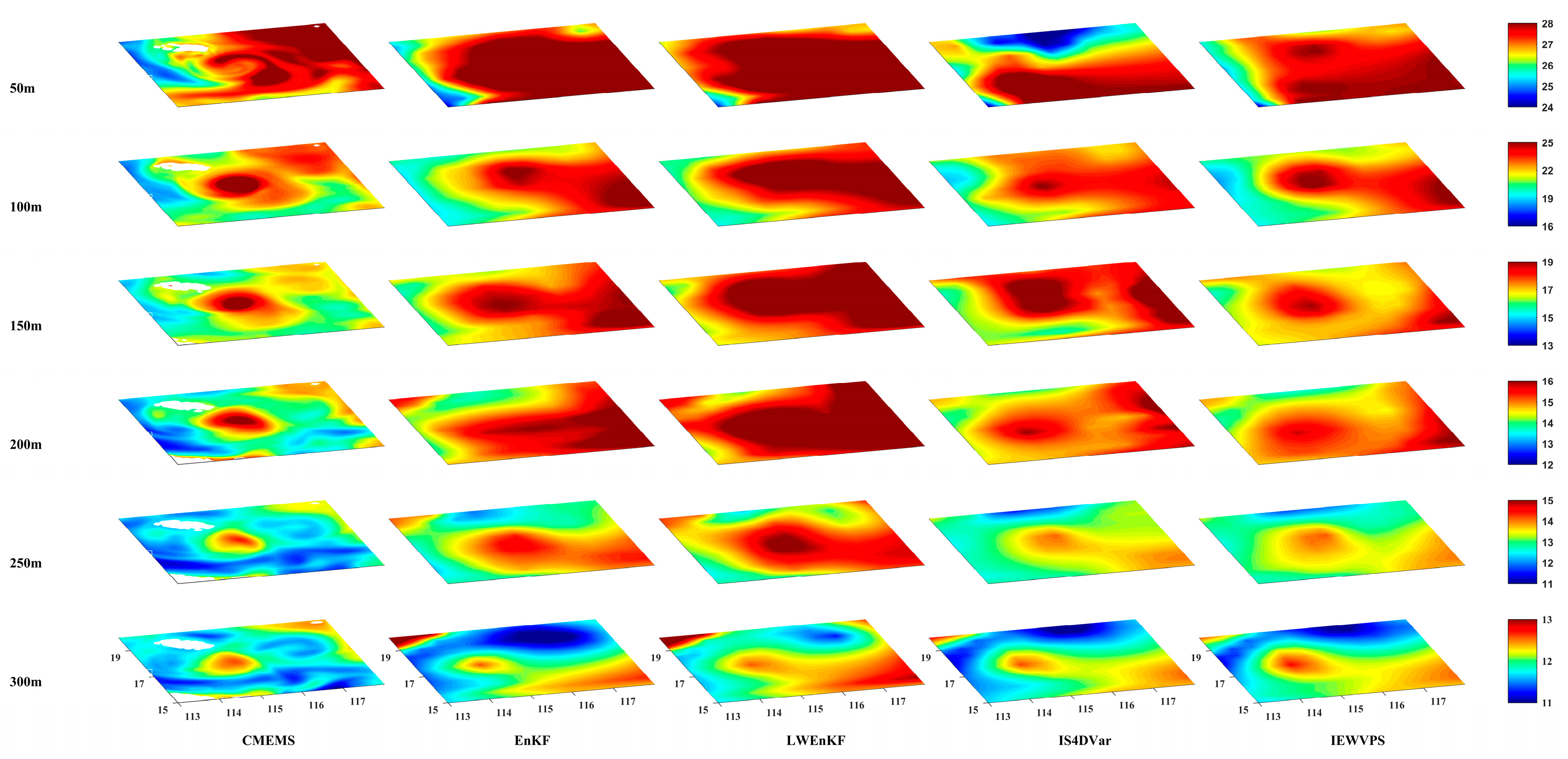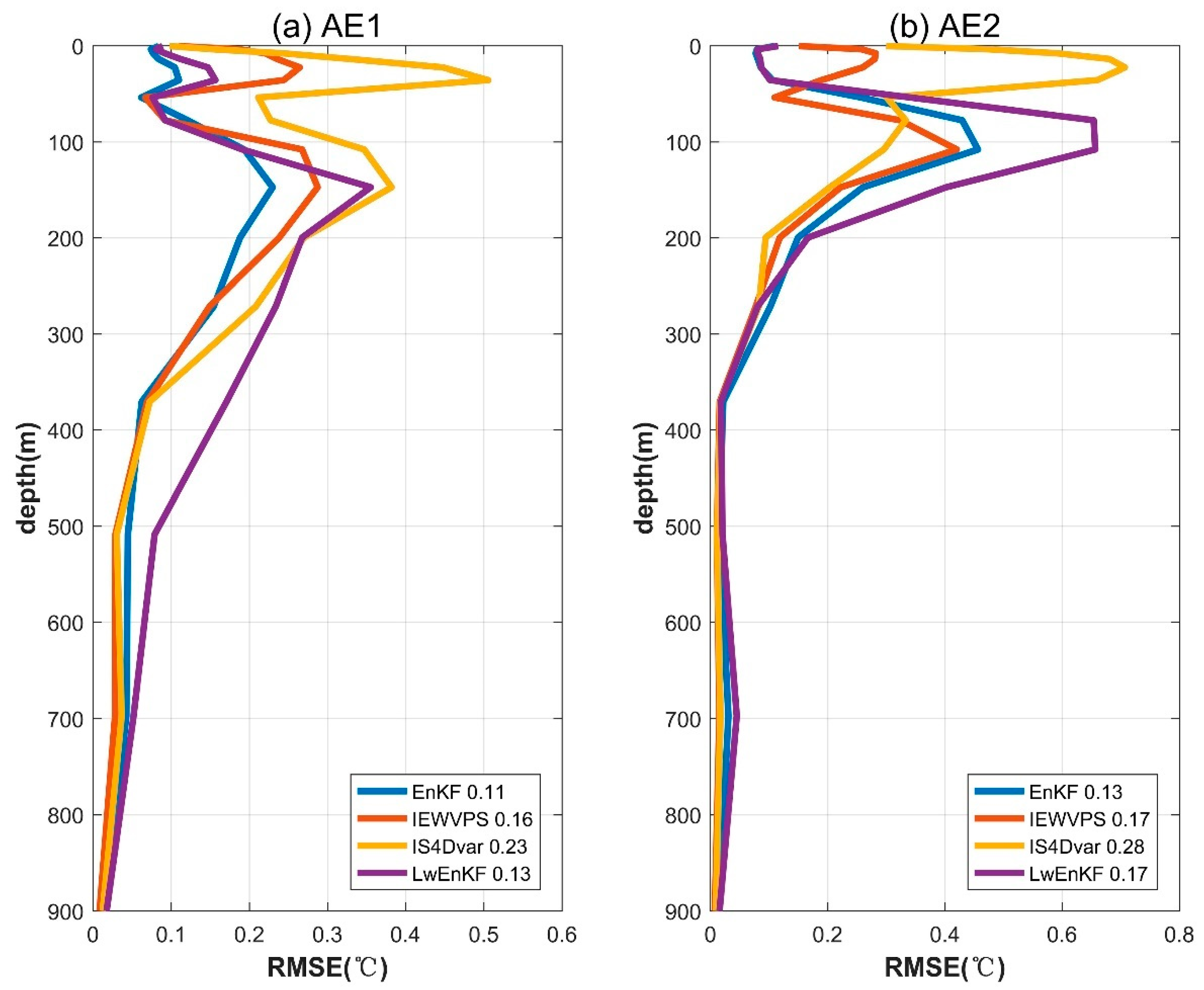1. Introduction
Numerical modeling represents an important way of analyzing and predicting the ocean’s state, as it can compensate for sparse and intermittent oceanic observations. However, uncertainties still remain in numerical ocean models due to the existence of inherent errors, such as hypotheticals and simplification of dynamics, approximate parametrizations, limited resolution, suboptimal initial conditions, etc. Moreover, these errors may accumulate over time, causing forecasts to increasingly deviate from the real state of the ocean. Currently, DA is the generally accepted method to decrease errors and improve the performance of simulations and functions by combining numerical models and observations [
1,
2,
3].
The main assimilation methods that are currently used in ocean DA are optimal interpolation (OI), three-dimensional variational (3DVAR) DA, four-dimensional variational (4DVAR) DA and ensemble Kalman filter (EnKF) [
4]. There are two theoretical frameworks used in ocean DA: the deterministic variational method and the Kalman filter method [
3]. Although the above DA methods have achieved great success in practical applications, they still remain a challenge, as their linear and Gaussian assumptions are not consistent with actual complex ocean models. The 4DVAR method depends heavily on the background error covariance matrix (B-matrix), while the B-matrix’s construction is based on various mathematical assumptions and a lack of dependence between assimilation windows [
5,
6,
7]. Although the EnKF method with Monte Carlo theories is a nonlinear development of the Kalman filter, the calculation of gain matrix still contains linear assumptions [
8]. At least in theory, the mainstream current DA methods are limited to linear assumptions. On the other hand, these methods also face potential questions in practical applications. For large numerical ocean models, developing an adjoint model (ADM) and a tangent linear model (TLM) of 4DVAR is very difficult; limited ensemble members of EnKF (usually less than one hundred) may cause sampling errors, spurious correlations and variance estimation errors [
9,
10].
Reasonable nonlinear/non-Gaussian filtering tools have been developed in mathematics, and one of the most famous is the particle filter (PF) [
11,
12,
13]. The PF method, which uses weighted particles to approximate posterior probability density functions (PDFs), continues to face the filter degeneracy problem in real geophysical models. This means the weight is concentrated on very few or even one particle. A lot of research has been carried out on filter degeneracy, and many interesting theoretical solutions have been put forward [
14]. The most well-known methods in practical application are proposal density [
15], localization [
16,
17], hybrid assimilation [
18] and other spin-off technologies. The two hybrid data assimilation methods—LWEnKF [
19,
20] and IEWVPS [
21]—are both designed by blending traditional and modern PF concepts of DA. LWEnKF is a new local particle filter that combines the localization and proposal density technologies, by mainly using the ensemble Kalman filter as the proposal density. IEWVPS is proposed to combine the merits of the implicit equal-weight particle filter and weak-constraint 4DVAR (IS4DVAR) [
22] by fusion of proposal density, implicit sampling and equal-weight ideas, and is the extension of implicit equal-weights particle filter (IEWPF) [
23] method in a four-dimensional space. The specific operation methods and procedures are interpreted in the next section.
Both LWEnKF and IEWVPS have been tested on the idealized Lorenz96 model [
24]. LWEnKF has been successfully applied to ROMS [
25] and FVCOM [
26], while IEWVPS has also been explored in ROMS [
27], which implies their considerable potential for operational applications. Although the two hybrid DA methods have been previously tested in ideal and real models, a more comprehensive comparison of different DA methods is necessary to establish a reference for the future development of assimilation techniques.
This study fills key gaps in the existing hybrid DA research with three explicit novelties for northern SCS mesoscale eddy simulation:
Unlike the existing studies that tested LWEnKF and IEWVPS separately [
25,
27], this study systematically compares the two methods in the complex northern SCS (with nonlinear mesoscale eddies and rugged seabed) under the same ROMS configuration (1/6° horizontal resolution, 24 vertical layers) and 61-day assimilation period, enabling direct performance benchmarking.
Beyond traditional short-term (≤7 days) surface assimilation (SLA/SST), this study expands to 16-day long-term eddy forecasting and a 50–200 m subsurface temperature assessment, addressing the gap of insufficient long-term predictability and subsurface analysis in the existing research.
By quantifying computational cost and linking it to performance, we find that LWEnKF matches IEWVPS’s SLA accuracy (posterior RMSE of 0.03 m compared to 0.02 m) with a much lower cost (24 s compared to 907 s per cycle), while IEWVPS excels in short-term eddy preservation (SLA RMSE < 0.05 m in the study area region within 10 forecast days)—a rare cost–performance analysis in hybrid DA literature.
Accordingly, we select a typical mesoscale eddy in the northern SCS as a case study to validate hybrid DA methods.
Mesoscale eddy plays an important role in the oceanic exchanges of mass and energy. The prediction of eddy’s time-varying parameters (position, scale, vorticity) is always a hot topic and a challenge for operational forecast models, as it has highly nonlinear features in the process of evolution (e.g., [
28,
29]). Many research studies prove that oceanic DA methods are helpful for mesoscale eddy simulation [
30,
31]. As mesoscale eddies are active all year round in the northern SCS, we compare the application of traditional and hybrid DA methods for the SCS’s mesoscale eddy simulation, and further discuss the potential of PF-based hybrid DA methods in the ROMS model. The outline of this paper is as follows:
Section 2 introduces the data, hybrid data assimilation methods and design of experiments in detail. The experiments of different DA methods are conducted in
Section 3, and then we report the long-term forecasting of mesoscale eddies in
Section 4. Then, we estimate the computational cost in
Section 5. The study discussion and conclusion are included in
Section 6.
3. Assimilation Experiments
Although the design processes of LWEnKF and IEWVPS are different, they all achieve their operation through the assimilation cycle, with the concept of “assimilation window”. For the convenience of comparison, we set the assimilation window for both assimilation methods to 1 day. In a window, the assimilated observations include gridded SST and SLA observations at the middle time of the window and all the T/S profiles within ±2 days of the middle time. The total assimilation cycle is 61 days, from 1 July to 30 August 2017. For a better comparison, we set up the control (without assimilation), EnKF and IS4DVAR experiments. Every method has been tested in prior (background) and posterior (analysis) simulation experiments. The other settings for the five assimilation tests are consistent with those in
Section 2.3.
The initial ensemble comprises the primary physical quantity information that governs state evolution, which holds significant importance in accelerating convergence to the true ocean state and enhancing filter performance during assimilation’s initial stage [
34]. Initially, the model undergoes an 11-year integration (2007–2017) without assimilating the observed data. Subsequently, a principal component analysis with the empirical orthogonal function (EOF) of the following decade’s data is conducted to extract the salient features of oceanic conditions. The ultimate initial ensemble is generated via an exact second-order sampling scheme:
In the aforementioned equation,
is derived from the patterns in the long-term results of the state on 1 July 2017.
represents the number of ensemble members;
represents a
sample matrix, which is composed of EOF principal components.
represents the row of a random matrix, which has a dimension of
with orthogonal columns and a sum equal to zero. This method for generating initial ensemble has been widely used in ocean data assimilation [
35]. Through the assimilation cycle, initialization not only improves the following forecast, but also advances the whole data assimilation and prediction quality. LWEnKF, IEWVPS, and EnKF all employ 40 ensembles, whereas IS4DVAR does not require ensemble and adopts the mean of the ensemble as the initial background field.
3.1. Comparison of Surface States
Three groups of 1-day forecasting results (on 14 July, 24 July and 3 August 2017) are shown in
Figure 2 and
Figure 3. There are three significant anticyclonic mesoscale eddies in the east and south of the simulated area, which can be seen from the SLA of AVISO data (
Figure 2a). From 14 July to 3 August, the anticyclonic eddy in the east (marked as AE1 and AE3) has undergone periodical strong and weak changes; while the other eddy in the middle (AE2) remains relatively stable, with the strength and position changing slightly (the red rectangle in
Figure 2(a-1)). There are significant differences between the control experiment and AVISO data, which indicate the substantial deviation from the real ocean surface states. Similarly, obvious differences exist among different types of DA methods. Although there are eddies observable in the target regions by EnKF, their shapes and intensities are significantly different from the AVISO data. By contrast, LWEnKF outperforms EnKF, but the forecast error is still large for AE1 among its results. Positions and shapes of the eddies predicted by IS4DVAR are in good agreement with AVISO as a whole, even if AE1’s strength is weaker than that observed. IEWVPS achieves the best results, whether in eddies or in the other regions.
Figure 3 shows the SST from the observation and model data. The result shows that the error of SST is significantly large both in the control experiment and reanalysis data. Especially for the control experiment, the SST is obviously higher over northern seas compared to that in AVHRR observations. The forecast results of EnKF and LWEnKF on 14 July are not ideal, with the predicted SST being generally higher than that of AVHRR. This is probably due to the longer adjustment time required for EnKF and LWEnKF assimilation, which cannot fully adjust in the early days. The effect of EnKF and LWEnKF tends to stand out over time. On 24 July and 3 August, forecasting results of the four assimilation tests match the AVHRR data well across most of the seas, and even better than the CMEMS reanalysis data. However, the predicted SST by Kalman filter methods is apparently higher in the northern coast. Next, we perform the quantitative calculation of the root-mean-squared error (RMSE) between simulated and true ones.
3.2. Statistics of RMSE
We calculate the RMSE of both prior (forecast) and posterior (analysis) results using spatial averaging at each analysis step. The time series and cumulative mean of RMSE are shown in
Figure 4 (SLA) and
Figure 5 (SST). The RMSE of prior SSH increases rapidly and deviates significantly from the true state of the ocean during the initial phase of the forecast. The RMSE of IS4Dvar and IEWVPS reaches a lower level after five assimilation windows, while it takes about 30 days for EnKF and LWEnKF to rank at the same level as that of IS4DVar. For the posterior results, the RMSE of IS4DVar shows an upward trend in the late assimilation period, which may be caused by the instability of the model. By the time of a long-running process, the advantages of EnKF and LWEnKF begin to emerge—the RMSE of EnKF and LWEnKF tends to be lower than that of IS4DVar after running for about 20 assimilation windows. Same as
Section 3.1, the RMSE of IEWVPS is still the lowest of all assimilation experiments and remains stable throughout the whole simulation. In terms of cumulative mean value, compared with the control experiment, EnKF, LWEnKF, IS4DVar and IEWVPS reduce RMSE by 55%, 65%, 65% and 80%, respectively. Noteworthily, the RMSE of EnKF and LWEnKF shows a downward trend in the late assimilation period, and LWEnKF approaches the level of IEWVPS, which indicates that LWEnKF would have a better assimilation effect after the initial adjustment.
Figure 5 shows the RMSE for prior and posterior SST data. Same as the SSH, a spatial average is taken every day. There are no definite differences between control and assimilation experiments in the first 7 days, but the RMSE of control results continuously increases, seriously deviating from the real SST. In the prior results, the RMSE of the four assimilation experiments is relatively stable during the whole cycle, and the mean of IEWVPS is the lowest. The decrease in the RMSE is 77%, 78%, 74% and 82%, respectively, for the EnKF, LWEnKF, IS4DVar and IEWVPS methods. In the posterior results, IS4DVar is more volatile, which may be caused by the model’s uncertainty, and assimilation is not sufficient for effective adjustment. A month into the assimilation experiment, the RMSE of EnKF and LWEnKF is lower than that of IEWVPS; by the end of the cycle, the three methods are essentially the same. In general, LWEnKF has the lowest posterior RMSE by cumulation over the entire assimilation period.
5. Computational Cost
When applying each assimilation method to actual services, it is necessary to evaluate not only its effectiveness but also its computational resource consumption. This section provides a comprehensive assessment of the computational costs associated with IEWVPS, IS4DVA, LWEnKF, and EnKF. In the numerical simulation test, an assimilation window of 1 day is set; that is, it takes 1 day to complete one assimilation cycle. In
Section 2.2.1, we presented the computational procedure of LWEnKF, whose computational cost mainly arises from the nonlinear model integration, proposal density stage that uses EnKF to assimilate the observation, calculate proposal and likelihood weights, update model variables in the merge step and perform KDDM correction for high-order moments. The main cost of IEWVPS is attributed to the 4D-PSAS and particle equal-weight adjustment. Specifically, the cost of 4D-PSAS arises from nonlinear, tangent and adjoint mode integrals. Moore et al. (2011a, b) presented the computational procedures of IS4DVAR and 4D-PSAS, both of which involve outer and inner loops [
5,
6]. The outer loop updates the model variables in a nonlinear mode, while the inner loop minimizes the cost function. In this experiment, 4D-PSAS in IS4DVAR and IEWVPS requires 1 outer loop and 30 inner loops within a time window. Therefore, in each assimilation cycle of IEWVPS, each particle undergoes 2 nonlinear model integrations for 4D-PSAS, 30 linear tangent model integrations and 31 adjoint model integrations. The weight adjustment component necessitates an additional nonlinear and linear model integral, as well as invoking MATLAB(R2021a) external for the calculation of
and
. The IS4DVAR solves in the primal space, requiring 2 nonlinear model integrations and 30 tangent linear and adjoint model integrations per assimilation cycle. In contrast, LWEnKF and EnKF do not require nonlinear, tangent linear and adjoint model integration, but have
and
cycles to sequentially process observations per assimilation cycle. Additionally, the localization radius has a significant impact on computational costs. The EnKF method employs a local parameter
of 0.02, and during the LWEnKF assimilation, the parameter
in the EnKF step can also be set to 0.02.
The computational time of one complete assimilation cycle for IEWVPS, IS4DVA, LWEnKF and EnKF is statistically analyzed in
Table 1. The testing hardware is an Intel Xeon CPU with 16 cores per node and 64 GB memory; a single particle is calculated in parallel using one node; the number of assimilated observations in each cycle is 3649. The statistical results indicate that the computational costs of Kalman filter methods are significantly lower than those of variational methods. In comparison with EnKF, an assimilation cycle in LWEnKF only takes 2 s longer. On the other hand, IEWVPS consumes approximately 20% less computing resources than IS4DVar. Noteworthily, the computational expense of an assimilation cycle in IEWVPS is approximately 38 times greater than that of LWEnKF. However, as the assimilation window length and mode resolution continue to increase, the computational cost of IEWVPS rises exponentially. In contrast, after a period of adjustment, LWEnKF can essentially achieve comparable assimilation effects to those of IEWVPS while maintaining significantly lower computational costs than both the IEWVPS and 4DVar methods, thus demonstrating strong potential for commercial applications. In general, the hybrid DA methods do not significantly increase computational costs compared to the traditional linear DA methods. Given its evident improvement in simulation accuracy, this approach holds great potential for future practical applications.
6. Discussion and Conclusion
DA is the foundation of ocean numerical prediction and reanalysis. While traditional methods such as EnKF, PF and 4DVAR have their own merits, they are inherently flawed in strong nonlinear systems. This study examines two novel hybrid DA techniques—LWEnKF and IEWVPS. Through theoretical integration, these new methods combine diverse assimilation benefits, thereby circumventing the assumption of model linearity and Gaussian error distribution. However, further verification is required to assess the applicability of hybrid DA methods in high-dimensional numerical models. Therefore, utilizing the ROMS-DART and ROMS-4DVAR assimilation systems with support from the regional ocean model ROMS, numerical simulation experiments are conducted in the northern SCS. The experiments are conducted over a two-month period, spanning from 1 July to 31 August 2017. Within the simulation region, two mesoscale eddies (AE1 and AE2) are consistently present. By comparing the effects of various assimilation methods on these eddies, the effectiveness of hybrid DA is evaluated. Furthermore, due to the complex topography of the northern shelf in the SCS and the abundant nonlinear seawater motion, this study can also test the stability of our assimilation system.
In the numerical simulation process spanning two consecutive months (with an assimilation window of 1 day), all four assimilation methods exhibit a relatively stable operation. Two measurement indices, namely SSH and SST, are selected to calculate the RMSE value between the simulation results (prior and posterior) and actual observed data. SST: Overall, both EnKF and LWEnKF deviate to some extent from the true ocean state (i.e., with larger RMSE values) in the early stages of the experiment. However, after approximately 20–30 assimilation cycles, the advantages of the Kalman filter gradually become apparent. At the advanced stage, the efficacy of EnKF and LWEnKF approaches that of IS4DVar and IEWVPS. LWEnKF outperforms EnKF, which underscores the benefits of PF combined with local weighting. In contrast, 4DVar-based methods exhibit less stability than EnKF-based methods and yield posterior results with significant RMSE fluctuations. Nonetheless, the IEWVPS method demonstrates superior performance compared to other methods throughout the simulation process and facilitates a smooth assimilation process. SSH: The analysis results based on SSH are essentially consistent with those of SST. In the early stages, the performance of the Kalman filter is inferior to that of the variational method. However, LWEnKF and IEWVPS exhibit similar behavior in later assimilation stages. Overall, the hybrid DA methods outperform the traditional assimilation methods in this test.
Based on the aforementioned research, we conduct a test on the long-term forecasting effect of mesoscale eddies. The initial fields are generated using the posterior data from four assimilation methods, and predictions are made for 16 consecutive days without further assimilation of observations. By comparing the distribution characteristics of eddies and the statistical RMSE, significant differences in prediction outcomes obtained from various initial fields are observed. After 5 days of model integration, the prediction results based on EnKF and LWEnKF initial fields indicate significant differences in mesoscale eddies’ morphology compared to actual observations. By the 10th day, it becomes difficult to discern the presence of eddies. In contrast, the 4DVar-based methods outperform the EnKF-based methods and can still identify mesoscale eddies’ characteristics by the 16th day. In addition, we also evaluate the forecasting of undersea temperature by different DA methods. The largest error occurs near the thermocline depth (50–200 m), which is also the depth where oceanic physical properties change most dramatically. In comparison, EnKF performs best in predicting underwater temperature, followed by IEWVPS and LWEnKF, while IS4Dvar shows the poorest performance. This may be related to the scarcity of T/S profile observation data in the northern SCS.
From the current development status of marine numerical models in various countries around the world, it is evident that the stability and computational complexity of 4DVAR and EnKF are significantly superior to those of the PF method. However, in the future, as the resolution of numerical models continues to increase, especially for the in-depth study of sub-mesoscale ocean processes, the advantages of the PF method will gradually become apparent. In addition, this study focuses on two warm eddies located in the northern part of the SCS, and further research is required to simulate the effect of cold ones. Obtaining more profile data within the mesoscale eddies’ region for comparison with model results would be beneficial in enhancing conclusion reliability. There is currently no definitive conclusion regarding the impact of these two mixed data assimilation methods on mesoscale eddy current fields, necessitating further verification. Furthermore, it is imperative to investigate the efficacy of mixed data assimilation techniques in high-resolution models. The particle filter framework for data assimilation offers the advantage of dispensing with the assumption of linear and Gaussian distribution, but its efficacy may not be fully demonstrated in simulating large-scale ocean phenomena characterized by weak nonlinear systems.
